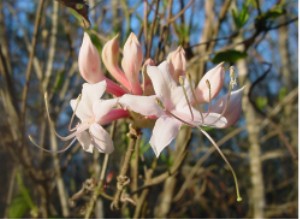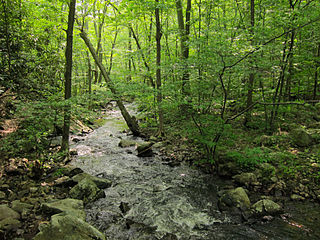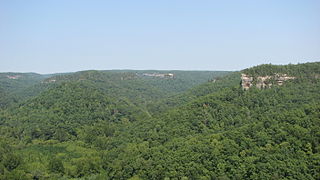
Rhododendron is a very large genus of about 1,024 species of woody plants in the heath family (Ericaceae). They can be either evergreen or deciduous. Most species are native to eastern Asia and the Himalayan region, but smaller numbers occur elsewhere in Asia, and in North America, Europe and Australia.

The Appalachian Mountains, often called the Appalachians, are a mountain range in eastern to northeastern North America. The term "Appalachian" refers to several different regions associated with the mountain range, and its surrounding terrain. The general definition used is one followed by the United States Geological Survey and the Geological Survey of Canada to describe the respective countries' physiographic regions. The U.S. uses the term Appalachian Highlands and Canada uses the term Appalachian Uplands; the Appalachian Mountains are not synonymous with the Appalachian Plateau, which is one of the provinces of the Appalachian Highlands.

Rhododendron atlanticum, the dwarf azalea or coastal azalea, is a species of Rhododendron native to coastal areas of the eastern United States, from New Jersey south to Georgia.

The Northeastern coastal forests are a temperate broadleaf and mixed forests ecoregion of the northeast and middle Atlantic region of the United States. The ecoregion covers an area of 34,630 sq miles (89,691 km2) encompassing the Piedmont and coastal plain of seven states, extending from coastal southwestern Maine, southeastern New Hampshire, eastern Massachusetts, and Rhode Island, southward through Connecticut, New York State, New Jersey, southeast Pennsylvania, Delaware and Maryland.
The Edith J. Carrier Arboretum is an arboretum and botanical garden on the James Madison University campus, located in Harrisonburg, Virginia, United States in the Shenandoah Valley. Groundbreaking for the arboretum took place April, 1985, under direction of Dr. Norlyn Bodkin,[1] who is credited the first scientific botanical discovery along the Eastern Seaboard of Virginia since the 1940s, Trillium: Shenandoah Wake Robin, presently found at the arboretum[2]. The only arboretum located on the campus of a Virginia state university. Exhibits include a developed trail system through 125 acres (0.51 km2) of mature Oak-Hickory Forrest with two identified century specimens and a species on the U.S. Fish and Wildlife Threatened Species list protected at the arboretum: Betula uber, Round-Leaf Birch.[3]

The Appalachian mixed mesophytic forests is an ecoregion of the temperate broadleaf and mixed forests biome, as defined by the World Wildlife Fund. It consists of mesophytic plants west of the Appalachian Mountains in the Southeastern United States.

Rhododendron occidentale, the western azalea or California azalea, is one of two deciduous Rhododendron species native to western North America. The western azalea is known to occur as far north as Lincoln and Douglas Counties in Oregon and as far south as the mountains of San Diego county. Typically found in the coastal ranges of western North America, it also grows in the Cascade and Sierra Nevada mountain ranges, but is not known east of them.

The Appalachian–Blue Ridge forests are an ecoregion in the Temperate broadleaf and mixed forests Biome, in the Eastern United States. The ecoregion is located in the central and southern Appalachian Mountains, including the Ridge-and-Valley Appalachians and the Blue Ridge Mountains. It covers an area of about 61,500 square miles (159,000 km2) in: northeast Alabama and Georgia, northwest South Carolina, eastern Tennessee, western North Carolina, Virginia, Maryland, and central West Virginia and Pennsylvania; and small extensions into Kentucky, New Jersey, and New York.

The Great Balsam Mountains, or Balsam Mountains, are in the mountain region of western North Carolina, United States. The Great Balsams are a subrange of the Blue Ridge Mountains, which in turn are a part of the Appalachian Mountains. The most famous peak in the Great Balsam range is Cold Mountain, which is the centerpiece of author Charles Frazier's bestselling novel Cold Mountain.

In the central and southern Appalachian Mountains of Eastern North America, a cove is a small valley between two ridge lines that is closed at one or both ends.
An oak–heath forest is a plant community association and type of forest ecology. It is a deciduous forest type of well-drained, acidic soils, characterized by oaks (Quercus) and plants of the heath family (Ericaceae). It is commonly found in the high elevations of the eastern United States. Such forest areas typically have a dense fibrous root layer at the surface of the soil, and in many areas predominate on south-facing or southwest-facing slopes. Many of the existing oak–heath forests once featured American chestnut as an important canopy species.

Rhododendron arborescens, also known as smooth azalea or sweet azalea, is a species of flowering plant in the family Ericaceae, native to the eastern seaboard of the United States.

Rhododendron austrinum is a species of flowering plant in the heath family known by the common names Florida flame azalea, honeysuckle azalea, southern yellow azalea, and orange azalea. It is native to the southern United States, where it can be found in Alabama, Florida, Georgia, and Mississippi. It is also a common ornamental plant.

Rhododendron vaseyi is a species of flowering plant in the heath family known by the common name pinkshell azalea. It is endemic to the Appalachian highlands of North Carolina in widely scattered locations. While there is a main center of distribution west of Asheville, there is also a large population on Grandfather Mountain, in the northwestern corner of the state.
The Central and southern Appalachian montane oak forest is a forest system found in the Appalachian Mountains of West Virginia, Virginia, Kentucky, Tennessee, North Carolina, South Carolina, and Georgia.
The Appalachian hemlock–northern hardwood forest is a forest system found in the Appalachian Mountains of New Hampshire, Vermont, Massachusetts, Connecticut, New York, New Jersey, Pennsylvania, Maryland, Virginia, Eastern Kentucky, West Virginia and western North Carolina. These forests occur in deep coves, moist flats, and ravines.
The northeastern interior dry–mesic oak forest is a forest system found in Maine, Vermont, New Hampshire, Massachusetts, Connecticut, Rhode Island, New York, New Jersey, Ohio, Pennsylvania, Maryland, Virginia, and West Virginia. These forests cover large areas at low and middle elevations, typically on flat to gently rolling terrain.

Clethra acuminata, the mountain pepper bush, is a shrub native to the Appalachian Mountains of the southeastern United States. It has been reported from the states of Pennsylvania, West Virginia, Virginia, North Carolina, South Carolina, Georgia, Alabama and Tennessee, primarily from deciduous forests at elevations of 500–1,400 m (1,600–4,600 ft).

North American azaleas are flowering shrubs in the genus Rhododendron, section Pentanthera, subsection Pentanthera, so named because they all have five stamens. Most are in the United States, with one species found in Canada and one being found in Mexico. North American azaleas are commonly confused with azaleas of Asian origin, the evergreen azaleas. North American azaleas are deciduous and produce two types of buds. One is a larger and produces about 20 flowers while the other bud produces a leafy shoot. The flower color, fragrance, and number of stamens vary among species.





















